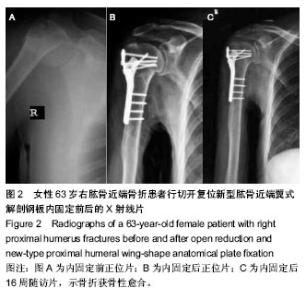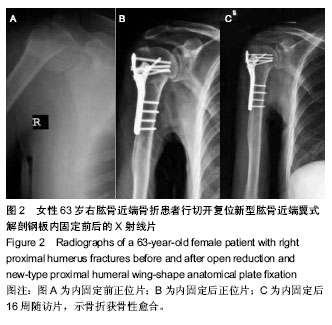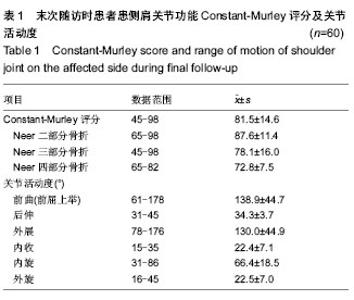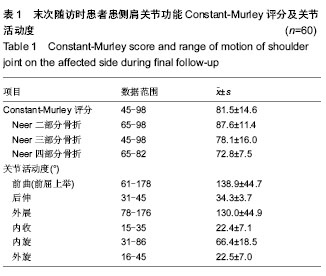| [1] 邱勤业,胡汉生,范震波,等.经皮钢板与解剖锁定钢板置入内固定治疗肱骨近端骨折[J].中国组织工程研究,2013,17(30): 5569-5574.
[2] 赵弟庆,张丽娜,杨广忠,等.MIPPO技术结合PHILOS治疗老年骨质疏松性肱骨近端骨折[J].中国矫形外科杂志, 2014,22(6): 508-511.
[3] 白力承,顾邵,熊鹰,等.锁定加压钢板置入肱骨近端骨折的最理想位置:选择肩外侧三角肌劈开入路?[J].中国组织工程研究, 2014,18(9):1453-1458.
[4] 郭洪亮,韩亚军,伊力哈木•托合提,等.劈三角肌与经三角肌胸大肌入路修复肱骨近端骨折的Meta分析[J].中国组织工程研究, 2014, 18(35):5723-5729.
[5] Kumar Gn K, Sharma G, Sharma V, et al.Surgical treatment of proximal humerus fractures using PHILOS plate.Chin J Traumatol. 2014;17(5):279-284.
[6] 刘磊,陈伟,孙家元,等.2003年至2012年河北医科大学第三医院成人肱骨近端骨折的流行病学研究[J].中华创伤骨科杂志, 2014, 16(4):320-323.
[7] Kim SH, Szabo RM, Marder RA.Epidemiology of humerus fractures in the United States: nationwide emergency department sample, 2008.Arthritis Care Res (Hoboken). 2012; 64(3):407-414.
[8] Palvanen M, Kannus P, Niemi S, et al.Update in the epidemiology of proximal humeral fractures.Clin Orthop Relat Res. 2006;442:87-92.
[9] 马福元,杨铁毅,姜锐,等.肱骨近端锁定加压钢板置入内固定治疗复杂肱骨近端骨折的并发症[J].中国组织工程研究,2013,17(48): 8381-8387.
[10] 陈立,赵弟庆,杨广忠,等.两种锁定钢板置入内固定治疗老年肱骨近端骨折[J].中国组织工程研究,2013,17(52):9011-9016.
[11] 徐丁,季烈峰,潘志军,等.内侧柱有效支撑与肱骨近端骨折锁定钢板固定术后疗效的相关性研究[J].中华骨科杂志,2013,33(11): 1091-1096.
[12] 陈志林,袁太珍,龚国龄,等.应用肱骨近端锁定钢板治疗肱骨近端骨折[J].中国骨与关节损伤杂志,2014,29(3):243-245.
[13] Hussain S, Gul M, Dhar S.Open reduction and Internal Fixation of Displaced Proximal Humerus Fractures with AO Stainless Steel T-Plate.Malays Orthop J. 2014;8(1):8-13.
[14] Koval KJ, Gallagher MA, Marsicano JG,et al.Functional outcome after minimally displaced fractures of the proximal part of the humerus.J Bone Joint Surg Am. 1997;79(2): 203-207.
[15] 陈海云,万鸣,陈平. Philos钢板与小夹板治疗肱骨近端骨折的疗效比较[J]. 中国中医骨伤科杂志,2014,22(7):15-17.
[16] 纪忠义,杨震,郑鹏,等.影响锁定钢板内固定治疗肱骨近端骨折术后肩关节功能的相关因素分析[J].中华创伤骨科杂志,2013, 15(9): 812-814.
[17] 曾浪清,陈云丰,刘燕洁,等.肱骨近端锁定钢板系统治疗成人肱骨近端骨折的疗效分析[J].中华创伤骨科杂志,2013,15(7): 624-626.
[18] 马广山.老年肱骨近端粉碎性骨折的治疗进展[J].实用骨科杂志, 2012,18(5):424-426.
[19] Sproul RC, Iyengar JJ, Devcic Z, et al.A systematic review of locking plate fixation of proximal humerus fractures.Injury. 2011;42(4):408-413.
[20] 叶庭均,王蕾.肱骨近端骨折切开复位内固定术后撞击征原因分析[J].国际骨科学杂志,2012,33(1):3-5.
[21] Neer CS 2nd.Displaced proximal humeral fractures. I. Classification and evaluation.J Bone Joint Surg Am. 1970; 52(6):1077-1089.
[22] Constant CR, Murley AH.A clinical method of functional assessment of the shoulder. Clin Orthop Relat Res. 1987; (214): 160-164.
[23] Court-Brown CM, Garg A, McQueen MM.The epidemiology of proximal humeral fractures. Acta Orthop Scand. 2001;72(4): 365-371.
[24] Roux A, Decroocq L, El Batti S,et al.Epidemiology of proximal humerus fractures managed in a trauma center.Orthop Traumatol Surg Res. 2012;98(6):715-719.
[25] Schliemann B, Siemoneit J, Theisen CH, et al. Complex fractures of the proximal humerus in the elderly--outcome and complications after locking plate fixation. Musculoskelet Surg. 2012;96Suppl 1:S3-11.
[26] Clavert P,Adam P,Bevort A,et al.Pitfalls and complications with locking plate for proximal humerus fracture.J Shoulder Elbow Surg.2010;19(4):489-494. |



